Appendix B Standard IT Project Documents
Appendix B Standard ITProject Documents
For this Appendix, we ve created some project templates that you might find helpful during project execution. You can find these documents as Microsoft Word and Excel spreadsheets on the companion CD of this book.
Initial Project Proposal Analysis Template
This document gives you different questions you can ask in order to determine the basic nature of the project request before you. Use this at initial project assessment time. When presented with an initial project proposal, it may be helpful to ask a few basic questions of your clients in order to clarify what the project entails:
Customer Information
Ask yourself and your team specific questions about the nature of your customer and its needs.
- Who is my customer?
- What is the problem or issue that we re trying to solve?
- If we solve this problem, how will we benefit?
- If we can t solve this problem, what will happen? (Is there a penalty that we might incur if we don t solve this problem?)
- What does the solution to the problem look like?
- What are the primary deliverables?
- What do you think this project will cost and where will the project funding come from?
- How long do you think the project will take?
- What does my customer have to do to ensure the success of the project?
- Who will be the sponsor of this project?
- Who will be the project manager?
Success Information
You need to decide the criteria that will determine project success. Ask yourself and your team these specific questions about the project you are tackling.
- By what metrics will we be able to measure that we ve successfully solved the problem or met the need?
- Will we increase sales? If so, what are current sales and what do we project future sales to be?
- Will we be lowering the costs of an operation? If so, what does the operation currently cost and what do we anticipate it will be after we ve implemented our solution?
- Will the overall quality of our product or service be enhanced? If so, what is the measurement of product or service quality now and what will it be when we re finished?
- Will our performance be improved? If so, what is the current measure of performance that we use and what does the enhanced measure look like?
Business Impact
You need to record the projected impact the project will have on your business. Ask yourself and your team these questions to determine if the project is right for your organization at this time.
- Are there other projects vying for corporate time and resources?
- How will competing projects be impacted should this project go forward?
- Do the other projects depend on the successful outcome of this project?
- What is the impact to the business for these other projects?
Issue Notification
Weve provided a document that you can use so that project team members or stakeholders can notify you of impending issues. The Issue Notification Worksheet, partially shown in the illustration below, would ideally be an email form or intranet document that utilizes workflow software in order to forward the document to key reviewers.
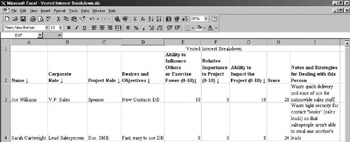
Risk Identification and Assessment
You would not begin a project without knowledge and understanding of the risks involved, therefore you must identify and assess these risks and keep them on record for the project team.
In the following table, we show a basic risk identification template that will be useful for you in your initial risk assessment efforts. Note that this is not an all-inclusive list! You ll want to add to the list as you work through your projects and identify more commonly held risks.
Basic Risk Identification Template
Use this template to identify basic risk assessment characteristics. Note that this template can be modified as you go forward in your project management work to account for other elements that you may encounter in your work.
In this table, in column 1, we ve identified project categories that are of interest to you. In column 2, you should identify the risk as you see it: L = Low, M = Medium, and H = High. In the notes section, make comments about the category to describe your thoughts about this particular category s risk to the project.
|
Category |
Risk (L/M/H) |
Notes |
|---|---|---|
|
Business Benefit |
L |
The project s benefit is well established. |
|
Project Scope |
L |
The scope of the project is understood and well defined. |
|
Sponsor |
L |
The sponsor has been identified and has accepted the responsibility. |
|
Customer Commitment |
L |
The customer is committed to the project and wants to see it completed. |
|
Project Manager |
L |
The project manager has worked on similar projects and understands the nature of what needs to be done. |
|
Project Team Location |
L |
The project team is centered in one location. (Geographic disparity adds risk to the project.) |
|
Project Methodologies and Processes |
L |
Project techniques, methodologies, procedures and processes are identified, well understood, and currently in practice corporate-wide. (Note: This does not necessarily imply that there s a PMO.) |
|
Business Requirements |
L |
The project s requirements have been firmly identified and defined and are well understood. |
|
System Availability |
L |
This risk identifies the amount of uptime that the system will actually be held to. Note that high-availability systems will naturally require more project planning and intervention. You should include system maintenance windows in your availability plans and note them in your risk assessment. |
|
Technical Requirements |
L |
The requirements put forth in this project are similar to projects we ve worked on before. |
|
Data Requirements |
L |
The data needs are easily defined, built, and maintained . |
|
Geography (deployment locations) |
L |
There is only one geographic location in which we ll be deploying this system. |
|
Integrated System |
L |
There are no other systems with which this project will have to interface. |
|
Business Units Affected |
L |
This project only affects one business unit. |
|
Number of Person-Hours Required |
L |
This project will require less than 1,000 hours to complete. (Note: You should determine the number of person-hours that makes up a Low, Medium, or High risk.) |
|
Subject Matter Expertise |
L |
The content of this project is well understood by the project team. |
|
External Dependencies |
L |
There are no external dependencies (such as vendors ) on which this project relies. |
|
Process Engineering |
L |
Business processes do not have to change ”processes are well-identified and are correct. |
|
Organizational Structure Modifications |
L |
No modifications to the organization s structure are required in order to enact this project. |
|
Technology |
L |
Current technologies (e.g., hardware, software, database, internetworking, etc.) can be used to bring about this project. |
|
Data Quality |
L |
The data in the current system has been properly normalized and lacks any integrity issues. Indexes, triggers, stored procedures, and other database elements have been well defined in the previous system. |
|
Project Costs |
L |
The costs of the project are accepted and not a problem. |
|
RFP/RFI/RFQ (also Feasibility Study) |
L |
The various Requests for Input, Requests for Proposal, Requests for Quote, and Feasibility Studies have returned favorable, cost-effective information about the project. |
|
Bleeding-Edge Quotient |
L |
This project is well within bounds of currently understood technologies |
|
IT Team Communication |
L |
All the IT teams that will be affected by or working on this project are on board and prepared for its inception. |
|
Infrastructure |
L |
The infrastructure is in place for the new system |
Risk Assessment
Perhaps another useful document for you will be a scorecard that you can use in determining the severity, in decimal form, that a given risk presents . The Risk Assessment and Mitigation Scorecard, shown below, requires that you key in a given risk (see examples already included in the form) along with a number from 0 “10 (1 “10 for the mitigation element) for various facets of the risk. Add the numbers up and you have your score. Work on making sure that the high scorers have a solid mitigation plan because they re the ones you re most likely to encounter. Remember that risk assessment and mitigation strategies are a team effort, so the form should be worked on at a team meeting.
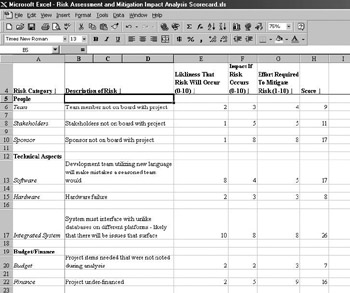
Vested Interest Breakdown
Another useful document, the vested interest breakdown shown in here, allows you to assess numerically the relative scores of each of your stakeholders. This scoring mechanism allows you to get a more concrete feel for the strength of the players involved with the project. If youre new to the company and not as politically astute as your team members , it would be helpful to have them review this matrix with you.
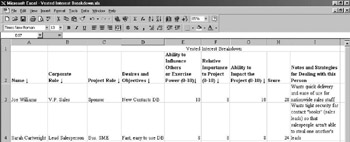
Human Resources Considerations
Its a good idea to keep records and charts regarding the people on a project team. Youll want to keep a Human Resources Assessment, a Skills Inventory worksheet, and a Responsibility Assignment document as well.
Human Resources Assessment
The Human Resources Assessment template, illustrated below, allows you to perform a basic assessment of each of your team members to identify their skills. You can use a scorecard rating of N = Neophyte, J = Junior, S = Senior for their experience level, or simply key in some text describing their experience. Note that you might have to fill out this matrix by visiting with the supervisors of the various team members on the matrix.
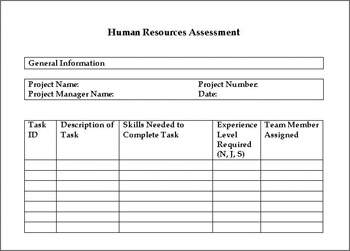
Skills Inventory Worksheet
Similarly, the Skills Inventory worksheet, illustrated here, will allow you to assess the education, training, and certifications of your various team members.
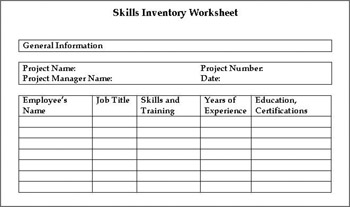
Responsibility Assignment Document
The Responsibility Assignments document, allows you to note a task, and then fill in the team members that will be working on that task. The legend provides a way for you to describe the level of involvement in a percentage of his or her time for a particular person.
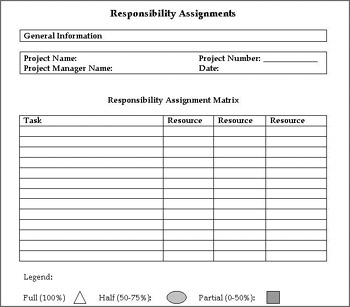
IT Project+ Study Guide
Assessment Test
Answers to Assessment Test
EAN: 2147483647
Pages: 173
- Chapter IV How Consumers Think About Interactive Aspects of Web Advertising
- Chapter VI Web Site Quality and Usability in E-Commerce
- Chapter VII Objective and Perceived Complexity and Their Impacts on Internet Communication
- Chapter XIII Shopping Agent Web Sites: A Comparative Shopping Environment
- Chapter XVIII Web Systems Design, Litigation, and Online Consumer Behavior
